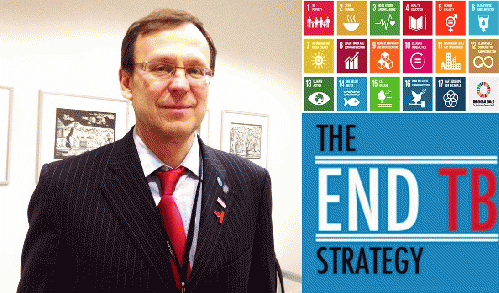
Dr Mario Raviglione, Director, WHO Global TB Programme
(Image by CNS (Citizen News Service)) Details DMCA
Video interview is online at: http://bit.ly/Ending-TB-by-2030
(CNS): This article is based upon an exclusive interview with Dr Mario Raviglione, Director of the WHO's Global TB Programme. Dr Raviglione spoke with CNS (Citizen News Service) at the 46th Union World Conference on Lung Health in Cape Town, South Africa. As we know, the Global Goals for Sustainable Development 2030 adopted by the governments at the 70th United Nations General Assembly in September 2015, present an integrated development agenda.
The Sustainable Development Goal (SDG) 3.3 specifically refers to ending AIDS, TB, malaria and neglected tropical diseases (NTDs) by 2030.
CNS spoke with Dr Raviglione on how will the commitments from the governments globally to SDGs, help accelerate progress on implementation of WHO End TB Strategy. Here is what he shared with us:
[To watch the video interview with Dr Raviglione, go to: bit.ly/Ending-TB-by-2030 ]
"The designers of the post 2015 End TB Strategy, had the foresight to align it with the philosophy of what are now endorsed by countries of the UN as the sustainable development goals (SDGs). The End TB Strategy aims to end the global TB epidemic, with targets to reduce TB deaths by 95% and to cut new cases by 90% between 2015 and 2035, and to ensure that no family is burdened with catastrophic expenses due to TB. The Goal 3.3 envisions by 2030 to end the epidemics of AIDS, TB, malaria and neglected tropical diseases and combat hepatitis, water-borne diseases and other communicable diseases. The End TB strategy hinges upon government stewardship and accountability with full participation of civil society and communities. It is based upon protection of human rights, ethics and equity. These are also enshrined in the SDGs.
The End TB Strategy insists upon universal health coverage - providing quality healthcare to all without having them incur catastrophic expenditures. It also stresses upon social protection mechanisms as mostly the TB patients are the poorest of the poor.
All this is incorporated in the End TB Strategy on top of its more technical aspects - make early diagnosis, provide treatment to everyone without distinction, focus on vulnerable population. There is also a push for prophylaxis, especially in populations with higher risks, where saving the life of the patient outweighs the risk of potential side effects. Also, there is need for more research and innovations in TB care and control. It will be difficult to reach the goals unless we transform the way TB is dealt with.
(Note: You can view every article as one long page if you sign up as an Advocate Member, or higher).





